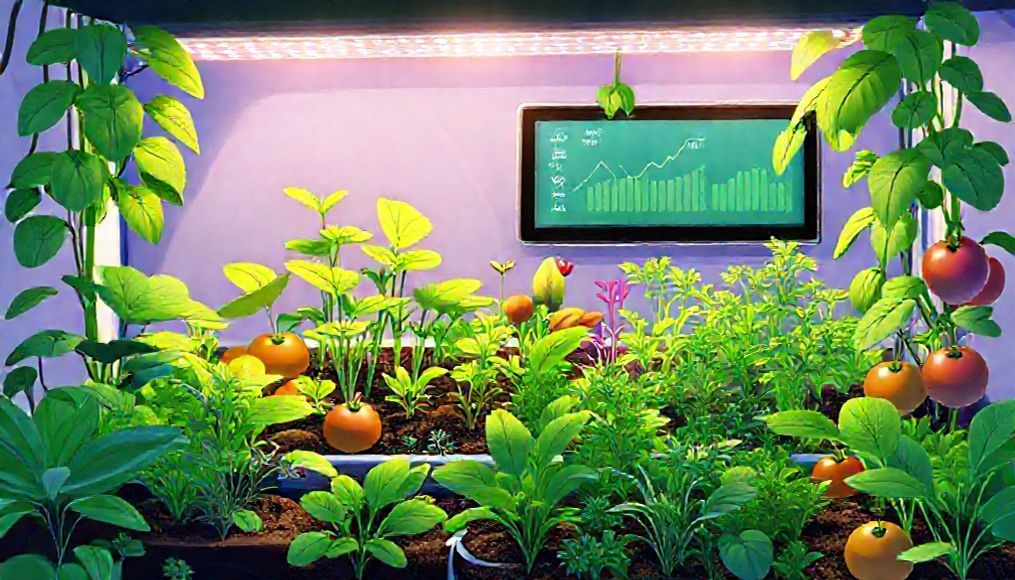Introduction: Smart Home Gardening - The Future of Food Savings
In the face of increasing economic challenges and rising food prices, home gardening has become an attractive option for individuals and families seeking self-sufficiency and reduced expenses. With the advent of modern technologies, home gardening has evolved into a broader and more efficient concept: "Smart Home Gardening."
Smart home gardening relies on the use of technology to increase productivity, reduce costs, and minimize resource consumption. These technologies include smart irrigation systems, sensors for monitoring soil and weather conditions, artificial lighting to promote growth, and smart applications for crop management. These tools help improve crop quality, reduce waste, and save water and energy.
Chapter 1: Benefits of Smart Home Gardening - More Than Just Saving Money
- Saving Money: Reducing reliance on purchasing vegetables and fruits from stores.
- Improving Health: Accessing fresh, organic, and pesticide-free food.
- Environmental Sustainability: Reducing the carbon footprint by minimizing the distances food travels.
- Increasing Nutritional Awareness: Better understanding of the plant life cycle and the importance of healthy food.
- Enhancing Quality of Life: Adding an aesthetic touch and relaxation area to the home.
Chapter 2: Smart Home Gardening Technologies - From Hydroponics to Automation
1. Hydroponics:
Involves growing plants in nutrient-rich water instead of soil. This method offers lower water consumption and allows for dense cultivation in small spaces.
Example: Vertical hydroponic systems can be used to grow lettuce, strawberries, and herbs in a small balcony area.
2. Aeroponics:
Relies on suspending plant roots in the air and spraying them with a nutrient solution. This method is the most efficient in terms of water and nutrient use.
Example: Aeroponic systems can be used to grow tomatoes, cucumbers, and peppers indoors.
3. Smart Irrigation Systems:
Use sensors to estimate plant water needs and distribute water effectively. These systems reduce water waste and ensure plants receive the appropriate amount.
Example: Programmed drip irrigation systems can ensure each plant receives the right amount of water at the right time.
4. Artificial Lighting (LED):
Uses LED lights to provide the necessary light for plant growth indoors or during the winter. This technology allows for year-round crop cultivation.
Example: LED lights can be used to grow herbs and leafy greens in the kitchen.
5. Sensors and Controls:
Use sensors to monitor temperature, humidity, and soil pH. These devices can send alerts to a smartphone or tablet if there is a problem.
Example: A sensor can monitor soil moisture and send an alert when watering is needed.
Chapter 3: Choosing the Right Crops for Smart Home Gardening
Selecting suitable crops depends on the available space, climate conditions, and family nutritional needs. Some crops are easy to grow and suitable for beginners, while others require more experience.
Examples of Suitable Crops:
- Leafy Greens: Lettuce, spinach, arugula, kale.
- Herbs: Mint, parsley, cilantro, basil.
- Fruits: Strawberries, cherry tomatoes, peppers.
- Root Vegetables: Radishes, carrots, green onions.
Chapter 4: Designing a Smart Home Garden - Practical Steps
- Determine Available Space: Balcony, rooftop, garden, or even indoors.
- Assess Climate Conditions: Amount of sunlight, temperature, humidity.
- Choose Appropriate Technologies: Hydroponics, aeroponics, smart irrigation, artificial lighting.
- Plan Garden Design: Strategically distribute plants to maximize space and light utilization.
- Purchase Equipment and Seeds: Choose high-quality equipment and certified seeds.
- Plant Seeds or Seedlings: Follow instructions carefully to ensure germination and healthy growth.
Chapter 5: Managing a Smart Home Garden - Tips for Maintaining Productivity
- Regular Watering: Ensure plants receive enough water.
- Fertilizing: Add organic or chemical fertilizers to provide necessary nutrients.
- Pest and Disease Control: Use organic or chemical pesticides when necessary.
- Pruning and Trimming: Remove dead or damaged leaves and branches.
- Continuous Monitoring: Regularly inspect plants for early detection of any problems.
Chapter 6: Costs and Returns - Economic Analysis of Smart Home Gardening
Smart home gardening is a long-term investment. Initial costs may be relatively high, but long-term returns outweigh these costs.
Costs: Purchasing equipment, seeds, fertilizers, electricity, water.
Returns: Saving money, accessing healthy food, improving quality of life.
Example: A family spending $150 per month on vegetables and fruits can save up to 50% of these expenses through smart home gardening.
Chapter 7: Examples from the Arab and Global Markets - Success Stories
There are many successful examples of smart home gardening in the Arab and global markets. Some individuals and families have achieved complete self-sufficiency in vegetables and fruits, while others have turned their hobby into a profitable business.
Example 1: A farmer in the United Arab Emirates uses hydroponics to grow lettuce and strawberries year-round.
Example 2: A woman in Egypt uses aeroponics to grow tomatoes and cucumbers on her balcony.
Example 3: A startup in the United States is developing customizable smart home gardening systems.
Chapter 8: Challenges and Solutions - Overcoming Obstacles in Smart Home Gardening
Smart home gardening faces challenges such as high initial costs, lack of experience, and difficulty in managing pests and diseases. However, there are many solutions that can help overcome these challenges.
Challenge: High initial costs.
Solution: Start with a small project and expand gradually, look for used equipment, take advantage of government grants and loans.
Challenge: Lack of experience.
Solution: Read books and articles, attend training courses, connect with experienced farmers, use smart applications.
Challenge: Difficulty in managing pests and diseases.
Solution: Use organic pesticides, grow disease-resistant plants, maintain garden cleanliness, regularly inspect plants.
Chapter 9: The Future of Smart Home Gardening - Towards Greener and More Sustainable Cities
Smart home gardening is part of a broader trend towards greener and more sustainable cities. With the increasing population in urban areas and the exacerbation of environmental challenges, smart home gardening will play an increasingly important role in providing healthy food, reducing the carbon footprint, and improving quality of life.
Predictions:
- Widespread adoption of smart home gardening systems in homes, commercial buildings, and educational institutions.
- Development of new, more efficient, and sustainable technologies.
- Increased awareness of the importance and benefits of smart home gardening.
Chapter 10: Conclusion - Start Today and Achieve Self-Sufficiency
Smart home gardening is a great opportunity to achieve self-sufficiency, reduce expenses, improve health, and contribute to environmental sustainability. Start designing your smart home garden today and enjoy the benefits of fresh, healthy food.
"Agriculture is not just a profession, it's a way of life." - Thomas Jefferson




